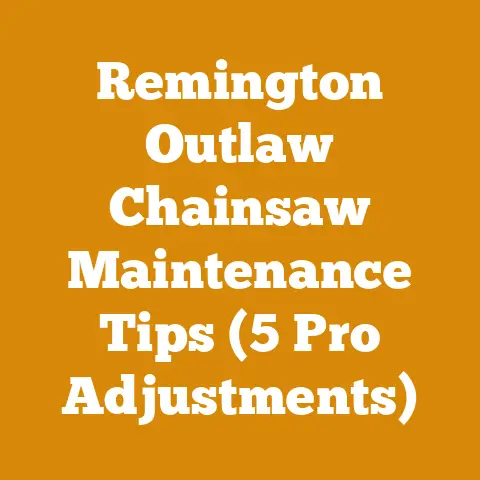Triple Axle Trailer Tips for Firewood Hauling (5 Expert Hacks)
The comforting scent of woodsmoke on a crisp autumn evening, the satisfying crackle of a well-built fire – that’s the kind of reward that makes all the hard work of firewood processing worthwhile. But getting that firewood from the forest to your hearth often involves a critical piece of equipment: the triple axle trailer. Hauling firewood safely and efficiently requires more than just a truck and a trailer; it demands knowledge, precision, and a healthy respect for the forces at play. Over the years, I’ve learned a few hard lessons (and avoided a few disasters!) hauling tons of firewood, and I want to share those experiences to help you navigate the world of triple axle trailer firewood hauling. These “expert hacks” are born from practical experience and are designed to boost your efficiency, safety, and peace of mind.
Triple Axle Trailer Tips for Firewood Hauling (5 Expert Hacks)
1. Mastering Load Distribution: The Key to Stability
Load distribution is arguably the most critical aspect of safe firewood hauling with a triple axle trailer. I’ve seen firsthand the disastrous consequences of a poorly loaded trailer – from fishtailing on the highway to blown tires and even rollovers. It’s not just about the total weight; it’s about where that weight is positioned.
The Science Behind It:
A triple axle trailer distributes weight across three axles, which provides greater stability and load-carrying capacity compared to single or tandem axle trailers. However, this advantage is negated if the load is not balanced correctly. Too much weight at the rear can cause “tail wagging the dog,” where the trailer pushes the tow vehicle around. Too much weight at the front increases tongue weight, potentially overloading the tow vehicle’s hitch and suspension.
My Experience:
I once loaded a trailer with green oak, thinking I was being clever by concentrating the heaviest wood at the front. Big mistake! The tongue weight was excessive, causing my truck to squat noticeably. More importantly, the steering became dangerously light. Even slight steering corrections resulted in exaggerated movements. I had to pull over, unload a significant portion of the front, and redistribute the weight. Lesson learned: even experienced haulers can make mistakes.
The Hack:
- 60/40 Rule: Aim for approximately 60% of the load weight to be positioned in front of the trailer axles and 40% behind. This ensures adequate tongue weight without overloading the tow vehicle.
- Even Distribution: Distribute the load evenly from side to side. Uneven weight distribution can cause the trailer to lean, increasing the risk of rollover, especially on uneven terrain or during cornering.
- Heavier Wood First: Always load the heaviest wood at the bottom of the trailer, close to the axles. This lowers the center of gravity, improving stability.
- Visual Check: Before setting off, visually inspect the trailer. Is it sitting level? Is the tow vehicle squatting excessively? These are signs that the load distribution may be off.
Data-Backed Insights:
- Tongue Weight: Aim for 10-15% of the total trailer weight as tongue weight. This is crucial for stability. Too little tongue weight can lead to trailer sway.
- Axle Load Ratings: Never exceed the axle load ratings specified by the trailer manufacturer. These ratings are typically stamped on the axles themselves. Overloading axles can lead to premature failure.
- Case Study: A study by the National Highway Traffic Safety Administration (NHTSA) found that improper load distribution was a contributing factor in over 20% of trailer accidents.
Technical Requirements:
- Weighing: Use a commercial scale to accurately weigh your trailer, both empty and loaded. This will help you determine the actual tongue weight and axle load distribution.
- Load Binders: Secure the load with heavy-duty load binders and straps. Ratchet straps are preferred for their ability to maintain tension.
- Safety Chains: Always use safety chains that are crossed beneath the trailer tongue. These chains are a critical safety feature in case of hitch failure.
2. Understanding Wood Moisture Content: Maximizing Your Payload and Profits
Hauling green firewood is like hauling water – you’re paying to transport something that will eventually evaporate. Understanding wood moisture content (MC) is crucial for maximizing your payload, reducing fuel consumption, and ensuring you’re selling a quality product.
The Science Behind It:
Freshly cut wood can have a moisture content of 50% or higher (on a dry weight basis). This means that half the weight of the wood is water. As the wood dries, it loses moisture, becoming lighter and more efficient to transport and burn. Seasoned firewood typically has a moisture content of 20% or less.
My Experience:
Early on, I made the mistake of hauling mostly green wood. I quickly realized I was wasting time, fuel, and money. The wood was heavy, difficult to handle, and took forever to dry. I invested in a moisture meter and started prioritizing seasoned wood. The difference was night and day. I could haul significantly more wood per load, and my customers were much happier with the quality.
The Hack:
- Invest in a Moisture Meter: A good moisture meter is an essential tool for any firewood hauler. It allows you to quickly and accurately assess the moisture content of the wood.
- Prioritize Seasoned Wood: Whenever possible, haul wood that has been properly seasoned. This will reduce your payload weight and improve fuel efficiency.
- Kiln-Dried Wood: Consider hauling kiln-dried wood for even greater efficiency. Kiln-dried wood typically has a moisture content of 10-15%, making it significantly lighter than air-dried wood.
- Species Matters: Different wood species dry at different rates. Softwoods like pine dry much faster than hardwoods like oak.
Data-Backed Insights:
- Weight Reduction: Seasoning firewood from 50% MC to 20% MC can reduce its weight by as much as 30-40%.
- Burning Efficiency: Dry firewood burns more efficiently and produces more heat than green firewood.
- Moisture Content Standards: Many jurisdictions have regulations regarding the maximum moisture content of firewood sold to consumers. Check your local regulations to ensure compliance.
Technical Requirements:
- Moisture Meter Calibration: Calibrate your moisture meter regularly to ensure accurate readings.
- Wood Stacking: Stack firewood properly to promote air circulation and faster drying.
- Drying Time: Allow sufficient time for firewood to dry before hauling it. The drying time will vary depending on the wood species, climate, and stacking method. Generally, hardwoods require at least 6-12 months of drying.
-
Wood Selection Criteria: Understanding how different wood species affects your hauling strategy is important.
- Hardwoods: Oak, maple, ash, and beech. Dense, burn long and hot, but take longer to season. Heavier when green.
- Softwoods: Pine, fir, spruce. Lighter, dry faster, but burn quickly. Lower BTU output.
- Mixed Loads: Common. Consider weight distribution, prioritize even distribution of species.
3. Tire Management: Preventing Blowouts and Maximizing Tire Life
Tires are the unsung heroes of firewood hauling. They bear the brunt of the load and are often subjected to harsh conditions. Proper tire management is essential for preventing blowouts, maximizing tire life, and ensuring safe operation.
The Science Behind It:
Tire pressure, load rating, and tread depth all play a critical role in tire performance. Underinflated tires generate excessive heat, increasing the risk of blowouts. Overloaded tires can also overheat and fail. Worn tires have reduced traction, especially in wet or icy conditions.
My Experience:
I once had a tire blowout on a fully loaded trailer while driving on the highway. It was a terrifying experience! The trailer started swaying violently, and I struggled to maintain control. Fortunately, I was able to safely pull over to the side of the road. The cause? An underinflated tire that had been neglected. I now make it a habit to check my tire pressure before every trip.
The Hack:
- Check Tire Pressure Regularly: Check your tire pressure before every trip, using a calibrated tire gauge. Inflate tires to the recommended pressure specified on the tire sidewall or in the trailer owner’s manual.
- Monitor Tire Temperature: During long hauls, periodically check the temperature of your tires. Excessive heat is a sign of underinflation or overloading.
- Rotate Tires: Rotate your tires regularly to ensure even wear. This will extend the life of your tires.
- Inspect Tires: Inspect your tires regularly for cuts, bulges, and other damage. Replace damaged tires immediately.
Data-Backed Insights:
- Underinflation: A tire that is underinflated by 20% can reduce its lifespan by as much as 25%.
- Overloading: Overloading a tire by 20% can reduce its lifespan by as much as 30%.
- Tread Depth: Tires with less than 2/32 inch of tread depth are considered unsafe and should be replaced.
Technical Requirements:
- Tire Pressure Monitoring System (TPMS): Consider installing a TPMS on your trailer. This system will alert you to low tire pressure or excessive tire temperature.
- Tire Load Rating: Ensure that your tires have a load rating that is sufficient for the weight you are hauling.
- Tire Age: Tires degrade over time, even if they are not used. Replace tires that are more than six years old, regardless of their tread depth. The manufacture date is stamped on the tire sidewall.
4. Optimizing Route Planning: Minimizing Fuel Consumption and Travel Time
Route planning is often overlooked, but it can have a significant impact on your fuel consumption, travel time, and overall efficiency. A well-planned route can save you time, money, and stress.
The Science Behind It:
Factors such as distance, elevation changes, traffic congestion, and road conditions can all affect fuel consumption and travel time. Choosing the most efficient route can minimize these factors.
My Experience:
I used to blindly follow GPS directions, often ending up on narrow, winding roads that were not suitable for a trailer. I realized I needed to be more proactive in my route planning. I started using online mapping tools to identify the most direct and trailer-friendly routes. The result? Reduced fuel consumption, faster travel times, and a much less stressful driving experience.
The Hack:
- Use Online Mapping Tools: Use online mapping tools such as Google Maps or TruckRouter to plan your routes. These tools allow you to specify your vehicle type (e.g., truck with trailer) and avoid roads that are not suitable for trailers.
- Consider Elevation Changes: Avoid routes with steep hills or mountains whenever possible. Hauling a heavy load uphill consumes significantly more fuel.
- Avoid Traffic Congestion: Plan your trips to avoid peak traffic hours. Sitting in traffic wastes fuel and increases travel time.
- Check Road Conditions: Check road conditions before you set off. Avoid routes with construction, closures, or other hazards.
Data-Backed Insights:
- Fuel Savings: Optimizing your route can reduce fuel consumption by as much as 10-15%.
- Travel Time Reduction: Planning your route can reduce travel time by as much as 20-30%.
- Accident Prevention: Avoiding hazardous roads can reduce the risk of accidents.
Technical Requirements:
- GPS Navigation System: Invest in a GPS navigation system that is specifically designed for trucks and trailers. These systems take into account the size and weight of your vehicle and provide routes that are safe and efficient.
- Paper Maps: Always carry paper maps as a backup in case your GPS fails.
- Communication: Carry a cell phone or two-way radio so you can communicate with others in case of an emergency.
5. Chainsaw Maintenance and Safety: Ensuring Efficient Cutting and Safe Operation
While not directly related to the trailer itself, chainsaw maintenance and safety are integral to the overall firewood hauling operation. A well-maintained chainsaw is essential for efficient cutting, and safe operation is paramount to preventing injuries.
The Science Behind It:
A sharp chainsaw cuts faster, requires less effort, and is less likely to kickback. Regular maintenance, such as sharpening the chain, cleaning the air filter, and lubricating the bar, will keep your chainsaw running smoothly and efficiently. Proper safety gear, such as a helmet, eye protection, hearing protection, and chainsaw chaps, will protect you from injuries.
My Experience:
I’ve had a few close calls with chainsaws over the years. One time, I was cutting a small tree when the chainsaw kicked back violently. Fortunately, I was wearing proper safety gear, and I escaped with only a minor scratch. That experience reinforced the importance of always wearing safety gear and following proper chainsaw safety procedures.
The Hack:
- Sharpen Your Chain Regularly: A sharp chain cuts faster and more safely. Sharpen your chain every time you refuel your chainsaw.
- Clean Your Air Filter: A dirty air filter restricts airflow, reducing engine power and increasing fuel consumption. Clean your air filter regularly.
- Lubricate Your Bar: Proper lubrication is essential for preventing wear and tear on your bar and chain. Lubricate your bar every time you refuel your chainsaw.
- Wear Proper Safety Gear: Always wear a helmet, eye protection, hearing protection, and chainsaw chaps when operating a chainsaw.
Data-Backed Insights:
- Kickback: Kickback is a major cause of chainsaw injuries. Proper cutting techniques and sharp chains can reduce the risk of kickback.
- Hearing Loss: Prolonged exposure to chainsaw noise can cause hearing loss. Wear hearing protection to protect your hearing.
- Eye Injuries: Flying debris can cause serious eye injuries. Wear eye protection to protect your eyes.
Technical Requirements:
- Chainsaw Calibration: Calibrate your chainsaw according to the manufacturer’s instructions. This will ensure that it is running efficiently and safely.
- Chain Tension: Adjust the chain tension regularly. A loose chain can come off the bar, posing a safety hazard.
- Fuel Mix: Use the correct fuel mix for your chainsaw. Using the wrong fuel mix can damage the engine.
-
Safety Training: Complete a chainsaw safety training course. This will teach you how to operate a chainsaw safely and efficiently.
- Chain Selection: Choose the right chain for the wood type.
- Bar Length: Select bar length appropriate for the job.
- Chainsaw Calibration Standards:
- Idle Speed: Set according to manufacturer specifications.
- High Speed: Adjust for optimal performance without over-revving.
- Carburetor Tuning: Fine-tune for efficient fuel consumption.
- Safety Equipment Requirements:
- Helmet: ANSI-approved with face shield.
- Eye Protection: Safety glasses or goggles.
- Hearing Protection: Earplugs or earmuffs.
- Chainsaw Chaps: Leg protection to prevent cuts.
- Gloves: Durable work gloves.
- Steel-Toed Boots: Foot protection against falling objects.
By implementing these five expert hacks, you can significantly improve the safety, efficiency, and profitability of your firewood hauling operation. Remember, knowledge is power, and a well-informed hauler is a successful hauler. Stay safe, stay informed, and enjoy the satisfaction of providing warmth and comfort to your community.






